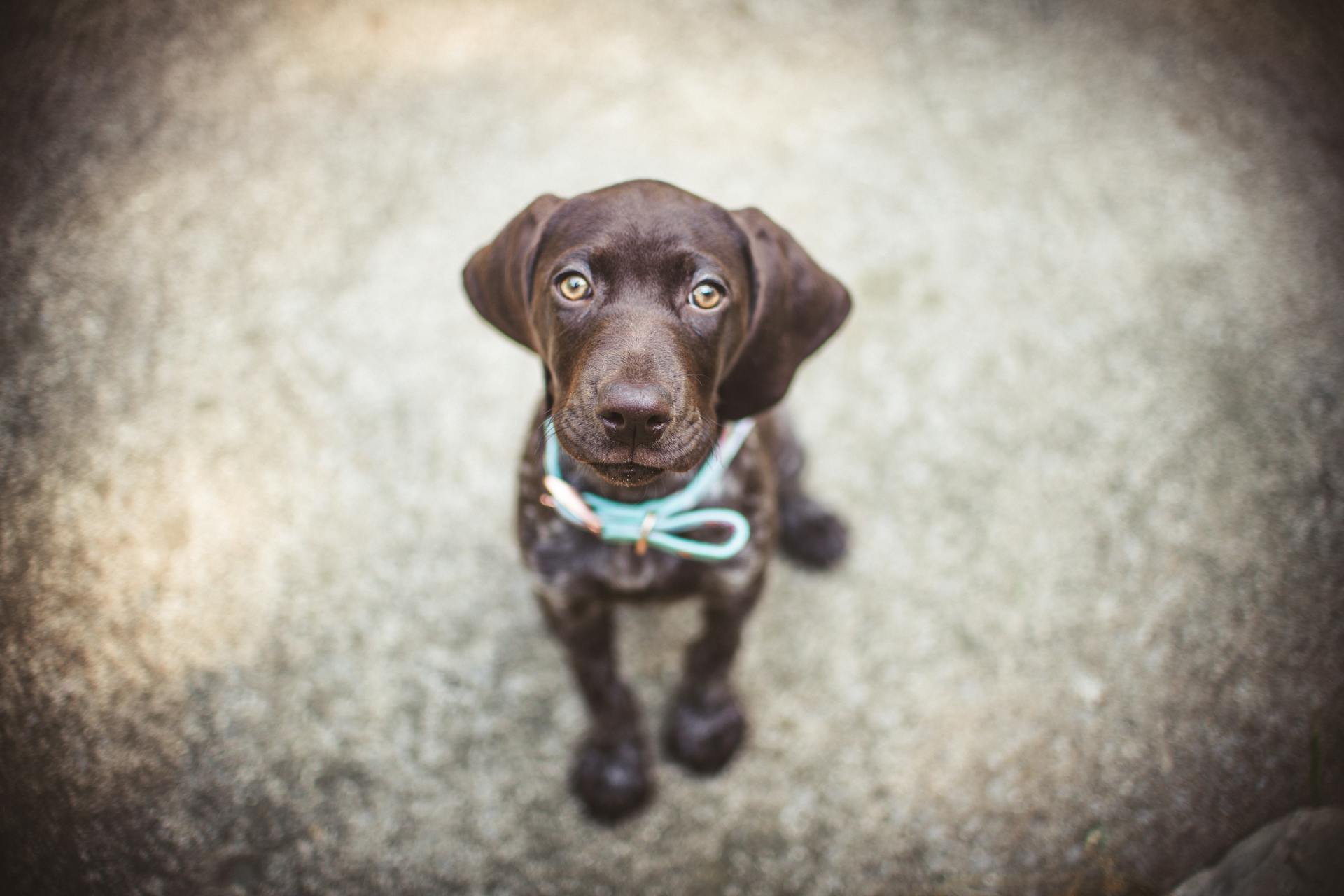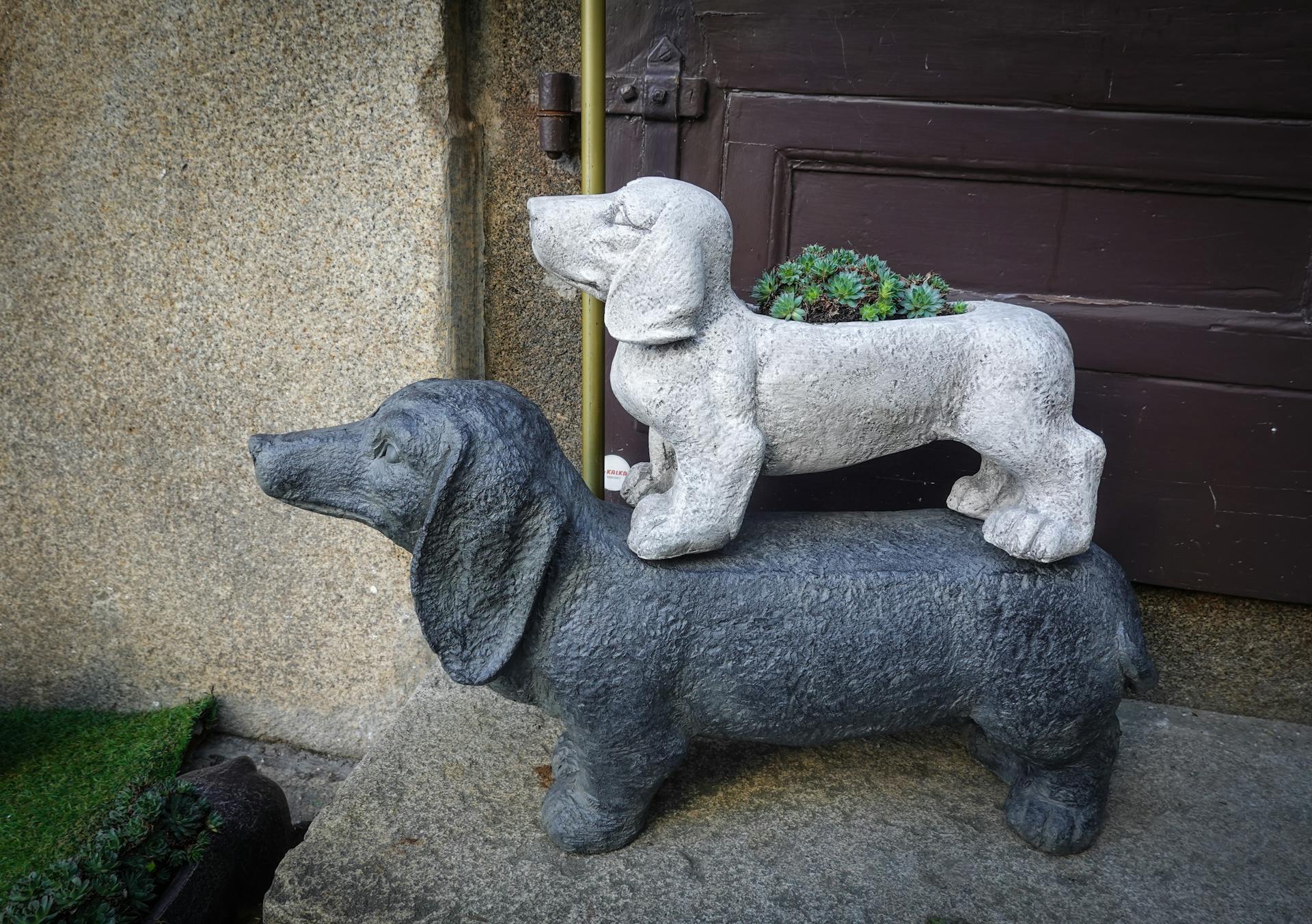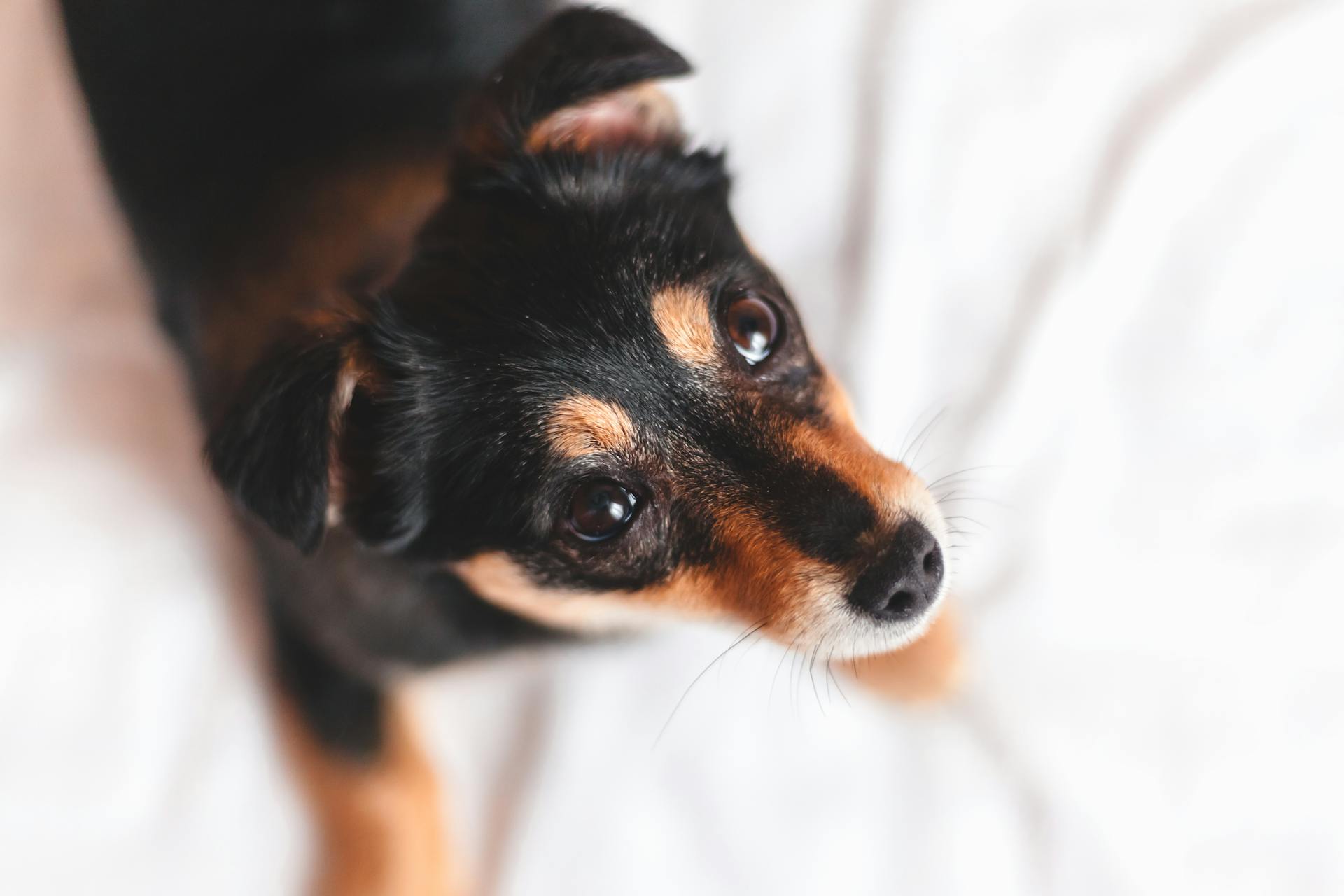
Dachshunds are a unique and lovable breed that's been a favorite among dog owners for centuries. They originated in Germany in the 16th century as hunting dogs, bred to chase badgers and other burrowing animals.
Their short stature and long bodies were designed for navigating tight spaces and chasing prey underground. Dachshunds come in a variety of coat types, including smooth, wirehaired, and longhaired.
Dachshunds are known for their bold and confident personalities, but they can be wary of strangers and may require time to warm up to new people. With proper socialization and training, they make great family pets.
Their intelligence and loyalty make them a popular choice for families with children, but they can be stubborn at times, requiring patient and consistent training.
Care and Maintenance
Dachshunds are generally low-maintenance when it comes to grooming, but they do require regular attention to their coat and nails.
They shed very little, which is a plus for many dog owners. However, their bellies may need more frequent brushing due to their close proximity to the ground, where they can pick up stickers or burrs.
Their nails need to be trimmed about once a month, and you'll know it's time when you hear them tapping on your hardwood floors. You can either do this yourself or have your groomer or vet help.
To keep your Dachshund's ears clean, you should wipe them at least once a week with a cotton ball. Be gentle and avoid going too deep to prevent irritation.
Here's a quick rundown of their grooming needs:
- Brushing: Short-haired Dachshunds can be brushed when needed, while long-haired and wire-haired varieties need to be brushed at least once a week.
- Bathing: Dachshunds only need to be bathed every few months, unless they get dirty.
- Nail Trimming: Trim their nails about once a month.
- Dental Care: Brush their teeth every day to prevent tartar buildup.
Breed Maintenance
Dachshunds are relatively low-maintenance when it comes to grooming. They shed very slightly, so you won't need to vacuum regularly. They also don't need frequent baths, unless they roll in something stinky.
Their coats require regular brushing, depending on the type. Short-haired Dachshunds can be brushed when needed, while long-haired and wire-haired varieties need to be brushed at least once a week, ideally a few times a week.
You'll want to use a slicker brush to get out tangles and then a bristle brush to keep the coat shiny. Long-haired Dachshunds need more frequent brushing to prevent knots and tangles, and they'll also need a bath more often.
A different take: When Do Maltese Dogs Stop Growing
Wire-haired Dachshunds, on the other hand, will need stripping once or twice a year. All Dachshunds need their ears wiped at least once a week with a cotton ball, making sure not to go too deep.
Their nails need trimming once a month, and you'll know it's time when you hear them tapping on your hardwood floors. Their teeth need brushing daily, starting from an early age to get them used to the experience.
Here's a rough guide to their grooming needs:
Keep an eye on their ears and clean them regularly to prevent infection or mites. You'll also need to maintain good oral hygiene by brushing their teeth a couple of times a week.
Training
Training is crucial for any dog, but it's especially important for Dachshunds due to their stubborn nature.
Dachshunds can be difficult to housebreak, so be prepared with puppy pads and cleaning supplies. Crate training may also be necessary to help with this process.
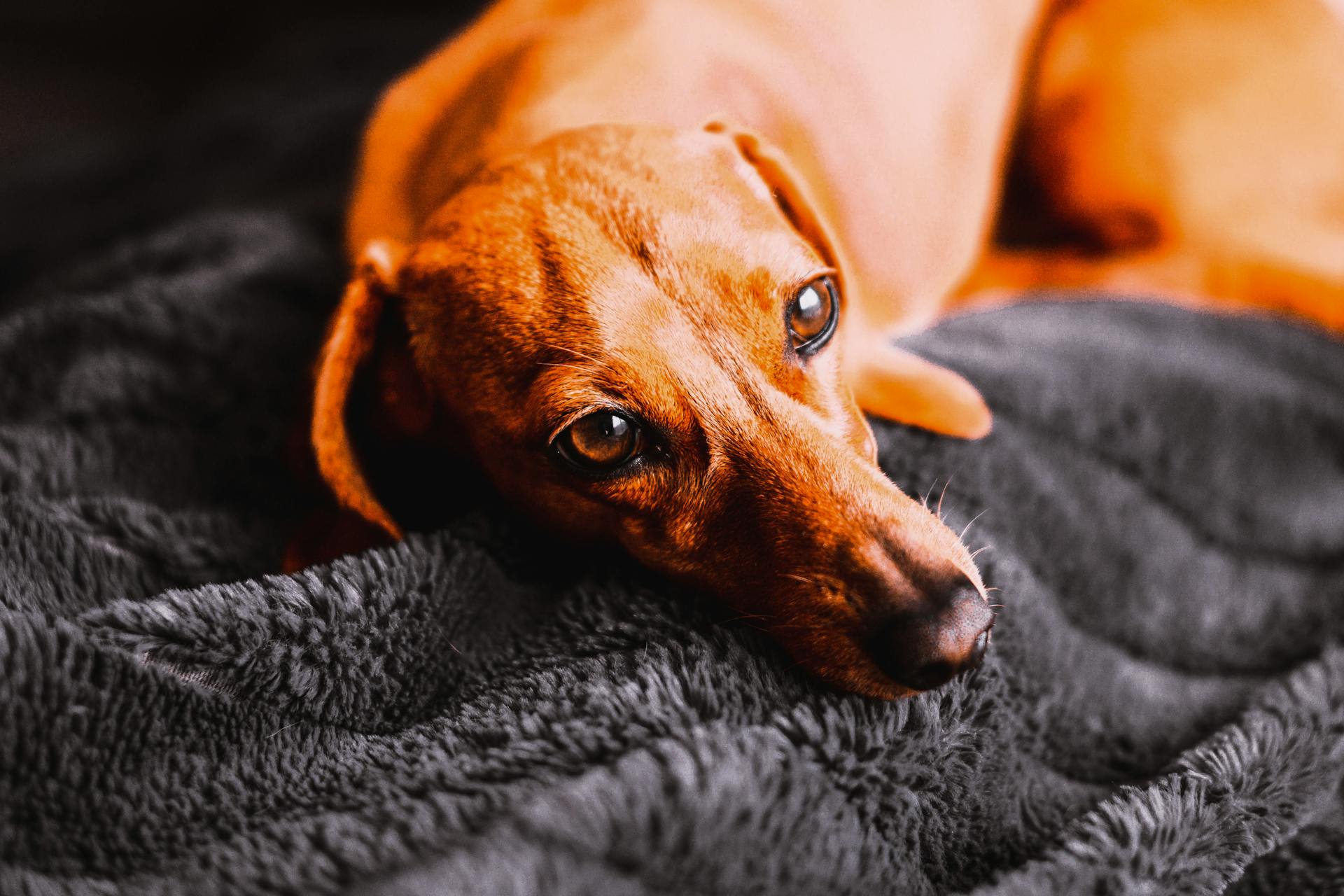
Positive reinforcement training is the way to go with Dachshunds. This method uses treats, toys, and praise to motivate your pup.
Keep training sessions short, as Dachshunds can get distracted easily. Use treats they absolutely love to keep them excited about learning.
Dachshunds have a powerful nose, so scent-based games are a great way to give them mental stimulation. Play hide-and-go-seek with treats to grab their attention.
Early socialization is key with Dachshunds. Start socializing your pup as soon as possible, and group obedience classes are a great place to begin.
Dachshunds do well with older children, but young children will need to be supervised when your dog is in the room.
On a similar theme: Homemade Treats for French Bulldogs
Health and Nutrition
Dachshunds can live for 12-16 years, but they do have some health issues to watch out for. Back problems are a common issue, with intervertebral disc disease (IVDD) affecting up to 25 percent of Dachshunds.
To reduce the risk of back problems, it's essential to avoid rough play or jumping, and to keep your Dachshund at a lean, healthy weight. You should also set up ramps or stairs to prevent them from jumping on furniture.
If this caught your attention, see: Straight Back German Shepherds
Here are some common health issues to look out for in Dachshunds:
- Intervertebral Disc Disease (IVDD)
- Bloat
- Deafness
- Luxating Patella
- Epilepsy
- Eye Problems (including cataracts, glaucoma, and progressive retinal atrophy)
A high-quality, commercial dog food is usually the best choice for Dachshunds. Make sure the food meets the nutritional standards of the Association of American Feed Control Officials (AAFCO) and is designed for your dog's stage in life.
Health Risks
Dachshunds are prone to back problems, with as many as 25% developing intervertebral disc disease (IVDD) at some point. This can lead to paralysis if not treated promptly.
To reduce the risk of back issues, it's essential to take care to protect your dachshund's back. Avoid any rough play or jumping, and always carry them by supporting their hind end with one hand and chest with the other.
Dachshunds can also develop bloat, a life-threatening condition where the stomach twists on itself. Symptoms can include being in pain, pacing, drooling, trying to throw up but not being able to, or licking their lips.
Other potential health concerns for dachshunds include deafness, epilepsy, and eye problems, including cataracts, glaucoma, and progressive retinal atrophy (PRA).
Here are some common health issues to be aware of in dachshunds:
- Intervertebral disc disease (IVDD)
- Bloat
- Deafness
- Epilepsy
- Eye problems (cataracts, glaucoma, PRA)
Diet and Nutrition

Dachshunds are prone to obesity, so it's essential to monitor their food intake and weight closely.
Their short legs can't handle excess weight, which can exacerbate back problems they're already prone to.
A high-quality food is a must, and you should choose a commercial dog food that meets the nutritional standards of the Association of American Feed Control Officials.
Make sure to check for the AAFCO statement on the package to ensure the food meets the necessary standards.
Consider your dog's age and activity level when deciding how much to feed them, as this will impact their nutritional needs.
Dachshunds have a good appetite due to their active nature, so be careful not to overfeed them.
Obesity can be a significant issue for Dachshunds, so it's crucial to keep track of treats and snack calories to avoid overfeeding.
Your veterinarian can help you determine the best feeding schedule and amount for your dog based on their individual needs.
A high-protein diet is essential for Dachshunds, and mixing up their food can keep mealtime interesting for them.
Regular exercise is also vital to maintain a healthy weight and overall well-being for your Dachshund.
A fresh viewpoint: Are Dachshunds High Maintenance
History and Etymology
The name dachshund is of German origin, and it literally means 'badger dog'. This makes sense, given their original purpose as hunting dogs.
In Germany, dachshunds are more commonly known by the short name Dackel, and working dogs are sometimes referred to as Teckel. The name dachshund is pronounced [ˈdaks.hʊnt] in German, but the pronunciation varies in English.
Dachshunds have a rich history dating back over 600 years to Germany, where they were bred to hunt badgers. Their narrow, low-to-the-ground body and confident personalities made them mighty hunters.
Consider reading: Giant Schnauzer Germany
History of the
The history of the Dachshund dates back to 15th century Germany, where they were bred as hunting dogs to hunt badgers.
Their original name, "Dachshund", translates to "badger dog" in German, a fitting moniker given their narrow, low-to-the-ground bodies that were perfect for digging into badger tunnels.
In the 17th century, the breed's development really began in Germany, with their stature, determination, and independence making them ideal for hunting badgers.
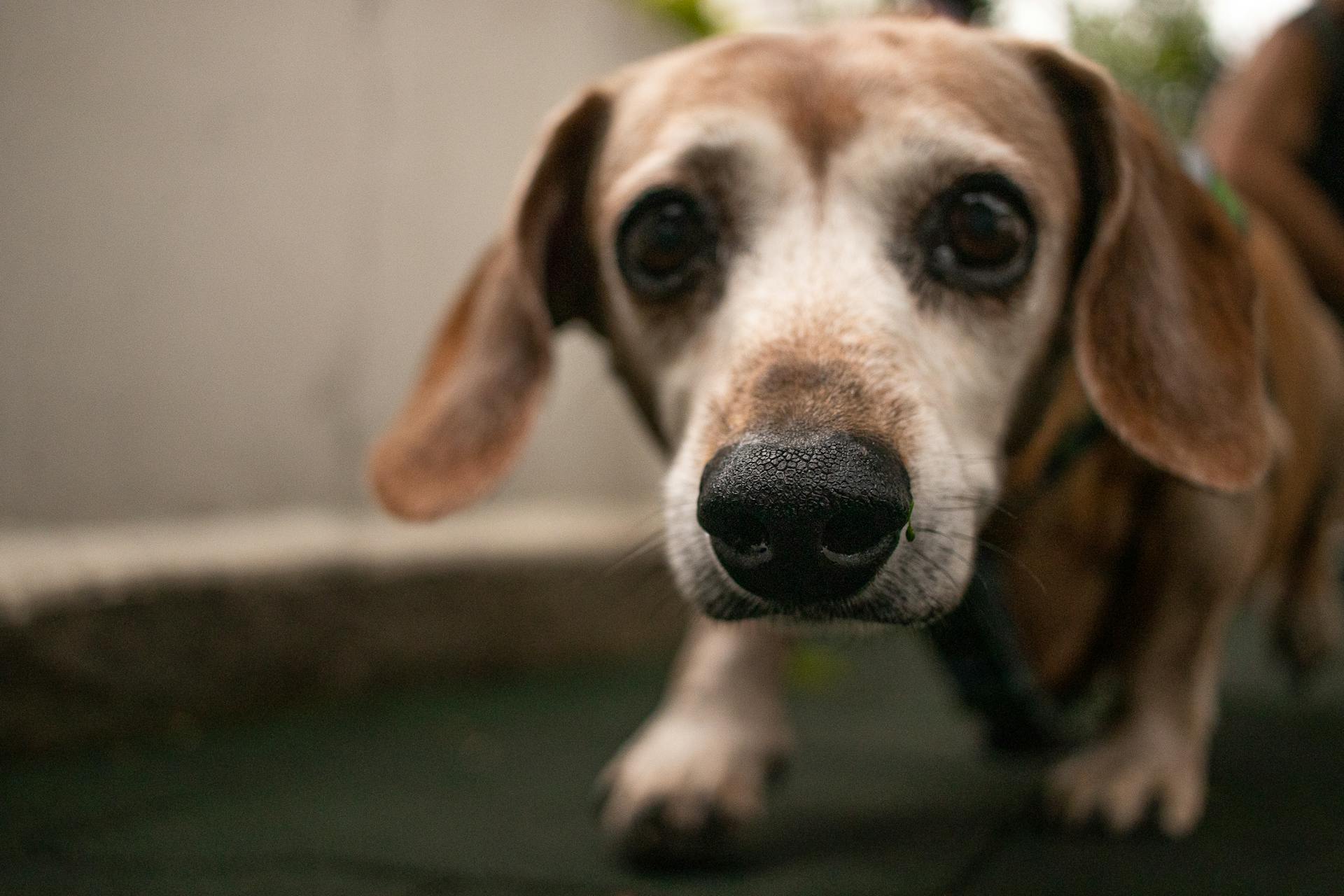
Dachshunds were brought to the U.S. as early as 1885 and were recognized by the American Kennel Club (AKC), but increased in popularity in the 1930s and 1940s.
Their original coat was short and smooth, but some were bred to have longer coats for colder climates, and others were bred to have wiry coats to help them avoid thorns when working in regions with brier patches.
The Dachshund's loud bark was once used to alert their humans to their whereabouts underground while hunting badgers.
In the 1800s, the Dachshund stopped being bred as a hunting dog and started to become a companion pet, becoming a favorite among royal courts in Europe, especially of Queen Victoria.
Dachshunds were first recognized by the American Kennel Club in 1885, but during World War I, they were used in German propaganda, leading the AKC to temporarily rebrand them as Badger Dogs or Liberty Pups in the United States.
Today, the Dachshund is a beloved breed, with numerous clubs dedicated to them, including the Dachshund Club of America.
Curious to learn more? Check out: American Bully Coats
Dackel Versus Teckel
In Germany, dachshunds are widely referred to as Dackel, both singular and plural. This is the common name used in everyday conversation.
Among hunters, however, they are mainly called Teckel. This distinction is rooted in the different breeding purposes, with some kennels specializing in hunting dachshunds.
There are two types of breeding: jagdliche Leistungszucht ("hunting-related performance breeding") and Gebrauchshundezucht ("working dog breeding"). These terms refer to breeding dachshunds for hunting purposes.
Interestingly, the name Teckel is sometimes incorrectly believed to be a mark for passing the test for a trained hunting dog (called "VGP", "Verband-Gebrauchsprüfung") in Germany.
Take a look at this: Breeding Double Dapple Dachshund
Notable Dogs and Owners
The ancient Egyptians revered dogs as sacred animals, often mummifying them to ensure their safe passage into the afterlife.
One notable example is the story of Ani, a 3,000-year-old Egyptian dog who was mummified and buried with her owner, a high-ranking official.
The Egyptians believed that dogs were associated with the god Anubis, who protected the dead and ensured their safe passage into the afterlife.
The bond between Ani and her owner was likely strong, given the care and attention that was given to her burial.
Dogs have been human companions for thousands of years, and their loyalty and affection have made them a beloved part of many cultures.
The ancient Greeks and Romans also revered dogs as loyal companions, often depicting them in art and literature as symbols of fidelity and devotion.
The Romans, in particular, were known to have kept dogs as hunting companions, using them to track and retrieve game.
The Romans also valued the protective qualities of dogs, often keeping them as guard animals to safeguard their homes and families.
Popularity and Ownership
Dachshunds are one of the most popular dogs in the United States, ranking 12th in the 2018 AKC registration statistics.
They're particularly well-suited for urban and apartment dwellers, who can find them among the top 10 most popular breeds in 76 of 190 major US cities surveyed by the AKC.
Discover more: Popular Pomeranian Dog
Adopt/Buy
If you're considering bringing a Dachshund into your life, you'll want to think about how to adopt or buy one.
Expect to pay between $500 to $1,500 for a Dachshund puppy from a breeder.
Keep in mind that rare color or marking combinations, like fawn (Isabella) or double dappled, can sometimes come with health issues.
Breeding for looks without considering health is not only unethical, but also unsafe.
If you're interested in adopting, start by contacting reputable organizations like the Dachshund Club of America, All American Dachshund Rescue, or Dachshund Rescue of North America.
These groups can provide guidance and help you find the next steps for adoption.
You can also try foster care to test if a Dachshund is a good fit for your home on a trial basis.
Here are some reputable organizations to contact for adoption:
- Dachshund Club of America
- All American Dachshund Rescue
- Dachshund Rescue of North America
Popularity
Dachshunds are one of the most popular dogs in the United States, ranking 12th in the 2018 AKC registration statistics.
They're a hit with urban and apartment dwellers, which is no surprise given their compact size.
In fact, Dachshunds rank among the top 10 most popular breeds in 76 of 190 major US cities surveyed by the AKC.
Size and Similar Breeds
If you're looking for a Dachshund, you might also consider breeds with similar maintenance needs. The Antebellum Bulldog, for example, is 100% similar in this regard.
If you're concerned about the Dachshund's size, there are several breeds that are similarly sized. The Doxie Scot, for instance, is about 93% similar in size.
Here are some breeds that are similarly sized and maintenance-wise to the Dachshund:
Characteristics of the
The Dachshund's physical characteristics are quite unique. They have small legs and long bodies, which makes them well-suited for digging.
Their playful nature means they can be quite energetic, but they also need regular exercise to stay happy and healthy. A medium exercise level is recommended.
One thing to keep in mind is that they have a tendency to chase smaller pets or wildlife, so they may not be the best fit for homes with other small animals.
Here's a quick rundown of their personality traits:
Their barking can be a bit of a challenge, but it's also a great way for them to alert you to potential issues outside the home.
Size
Dachshunds come in three sizes: standard, miniature, and kaninchen, which is German for "rabbit". The standard and miniature sizes are recognized almost universally, but the kaninchen size is not recognized by clubs in the United States and the United Kingdom.
A full-grown standard dachshund typically weighs between 16 and 32 pounds, while the miniature variety normally weighs less than 12 pounds. The kaninchen weighs between 8 and 11 pounds.
Dachshunds have a unique body shape, with short legs and long bodies. Those short legs are much more powerful than they might look, and their feet are big compared to their legs.
Here are the different sizes of Dachshunds, along with their typical weights:
Similarly Sized Breeds
If you're looking for breeds that are similar in size to Dachshunds, you have a few options. Here are some breeds that are comparable in terms of size.
The Doxie Scot is a great example, with a similarity rating of 93%. This breed is a cross between a Dachshund and a Scottish Terrier.
The Sealyham Terrier is another breed that's similar in size, with a similarity rating of 92%. They're a small to medium-sized breed that's known for their energetic and playful personalities.
The Dandie Dinmont Terrier is also a great option, with a similarity rating of 92%. They're a small breed that's known for their distinctive beards and mustaches.
If you're looking for something a bit more unique, the Silkshund is a great choice, with a similarity rating of 90%. This breed is a cross between a Silky Terrier and a Dachshund.
For those who want a breed that's a bit more energetic, the Scorkie is a great option, with a similarity rating of 89%. This breed is a cross between a Scottish Terrier and a Yorkshire Terrier.
Here are some breeds that are similar in size to Dachshunds:
- Doxie Scot (93% Similar)
- Sealyham Terrier (92% Similar)
- Dandie Dinmont Terrier (92% Similar)
- Silkshund (90% Similar)
- Scorkie (89% Similar)
Similar Maintenance Breeds
If you're looking for breeds that require similar maintenance to a Dachshund, there are a few options to consider.
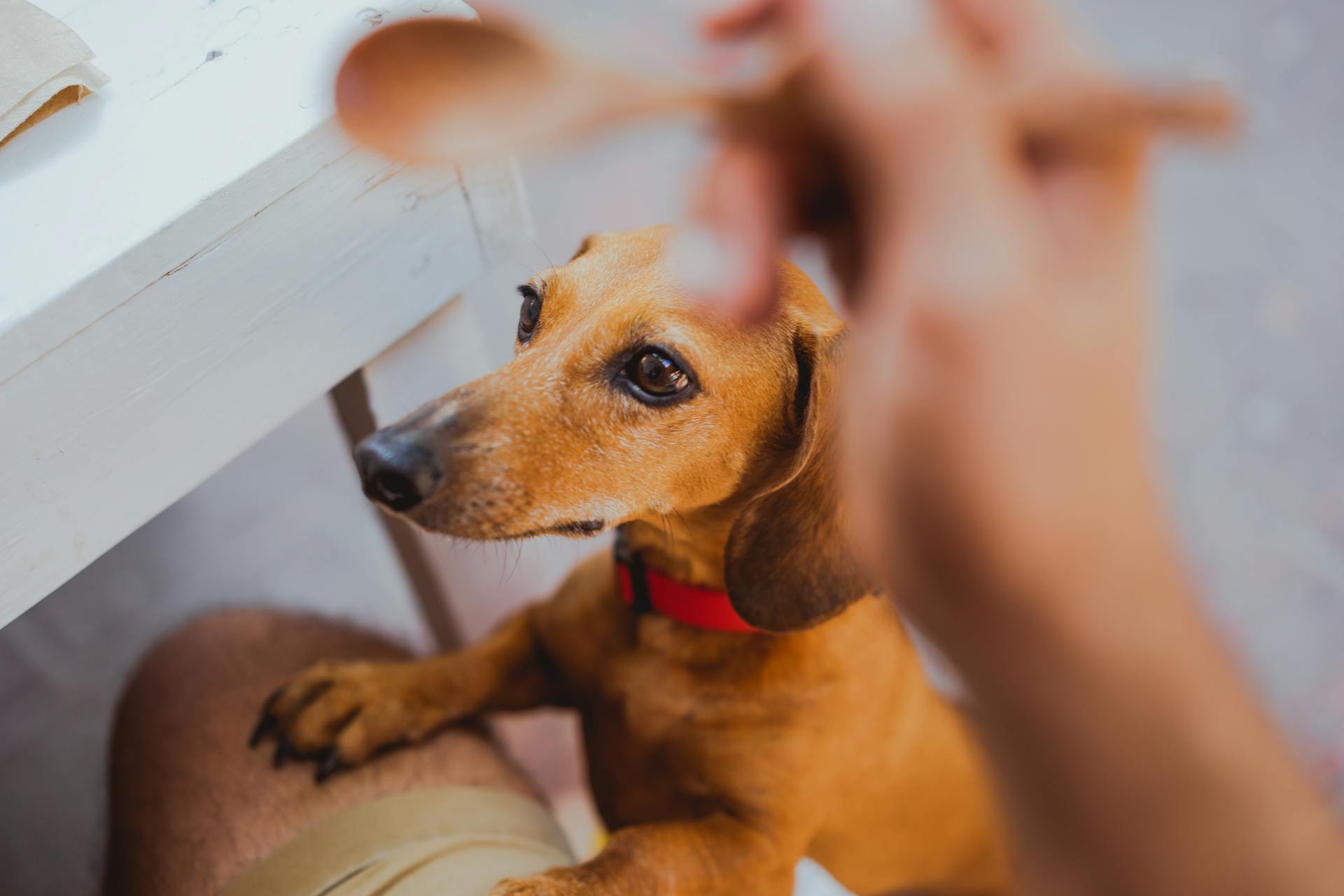
The Antebellum Bulldog is 100% similar in maintenance needs to a Dachshund, which means they likely require similar exercise, grooming, and training.
The Australian Cattle Dog is also 100% similar, suggesting they have similar energy levels and require regular physical and mental stimulation.
If you're looking for a breed with a slightly lower maintenance requirement, the Mini Foxie Doxie is 96% similar to a Dachshund, requiring less exercise but still needing regular grooming and training.
The German Shepherd is also 96% similar, which means they'll need regular exercise, training, and mental stimulation to prevent boredom and destructive behavior.
The Black and Tan Coonhound is another breed that's 96% similar in maintenance needs to a Dachshund, requiring regular exercise and training to keep them happy and healthy.
Here are some breeds that are similar in maintenance needs to a Dachshund:
- Antebellum Bulldog (100% Similar)
- Australian Cattle Dog (100% Similar)
- Mini Foxie Doxie (96% Similar)
- German Shepherd (96% Similar)
- Black and Tan Coonhound (96% Similar)
Frequently Asked Questions
Are Dachshunds good house dogs?
Yes, Dachshunds make great house dogs, but they thrive on human interaction and may not be suitable for owners who are away from home for long periods.
Are Dachshunds expensive?
Dachshunds can be a costly companion, with adoption or purchase prices ranging from $150 to $3,500, and monthly care costs averaging $155 to $855+. However, the rewards of owning a Dachshund make the investment well worth it.
Do Dachshunds bark a lot?
Dachshunds were bred to be expert barkers, making them more prone to barking than other breeds. Their keen senses and hunting instincts still drive their barking behavior today.
Featured Images: pexels.com
